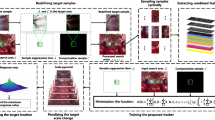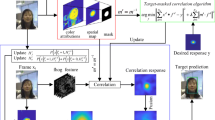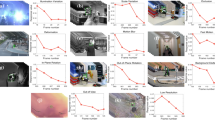Abstract
In recent years, correlation filter (CF)-based trackers have undergone rapid development and achieved state-of-the-art performance. However, CF-based trackers lack the ability to perceive the local variation of the target, such as occlusion, because they rely on the features from a bounding box to distinguish the target. In contrast, segmentation-based trackers, which distinguish the target based on pixel- or superpixel-level information, can sufficiently perceive local variation. However, their robustness is inferior to that of CF methods due to the lack of high-level semantic information. In this research, the advantages of both methods were combined to improve the anti-occlusion ability of CF trackers. The image segmentation-based occlusion estimation agency (ISBOEA) method is proposed to perceive occlusions, after which the occlusion information is used to guide the training and searching of CF trackers. In experiments conducted in this study, two CF-based trackers, namely the background-aware CF (BACF) and the efficient convolution operators: hand-crafted feature version (ECO_HC), were employed as baselines for tracking. Moreover, the minimum barrier distance (MBD) transform method was employed to conduct image segmentation. Extensive experiments were performed on standard benchmark datasets, namely OTB50, OTB100, GOT-10k and VIVID. The results demonstrate that the proposed ISBOEA method can remarkably improve the anti-occlusion ability of CF-based trackers.







Similar content being viewed by others
References
Bertinetto L, Valmadre J, Henriques JF, Vedaldi A, Torr PHS (2016) Fully-convolutional siamese networks for object tracking. In: Hua G, Jégou H (eds) Computer vision - ECCV 2016 workshops. Springer International Publishing, Cham, pp 850–865
Bolme DS, Beveridge JR, Draper BA, Lui YM (2010) Visual object tracking using adaptive correlation filters. In: 2010 IEEE computer society conference on computer vision and pattern recognition. IEEE, pp 2544–2550
Collins R, Zhou X, Teh, SK (2005) An open source tracking testbed and evaluation web site. In: IEEE international workshop on performance evaluation of tracking and surveillance, vol 2. p 35
Danelljan M, Bhat G, Shahbaz Khan F, Felsberg M (2017) Eco: Efficient convolution operators for tracking. In: Proceedings of the IEEE conference on computer vision and pattern recognition. pp 6638–6646
Danelljan M, Hager G, Shahbaz Khan F, Felsberg M (2015) Convolutional features for correlation filter based visual tracking. In: Proceedings of the IEEE international conference on computer vision workshops. pp 58–66
Guo D, Wang J, Cui Y, Wang Z, Chen S (2020) Siamcar: Siamese fully convolutional classification and regression for visual tracking. In: 2020 IEEE/CVF conference on computer vision and pattern recognition (CVPR). pp 6268–6276. https://doi.org/10.1109/CVPR42600.2020.00630
Henriques JF, Caseiro R, Martins P, Batista J (2012) Exploiting the circulant structure of tracking-by-detection with kernels. In: European conference on computer vision. Springer, pp 702–715
Hong Z, Wang C, Mei X, Prokhorov D, Tao D (2014) Tracking using multilevel quantizations. In: European conference on computer vision. Springer, pp 155–171
Huang L, Zhao X, Huang K (2021) Got-10k: A large high-diversity benchmark for generic object tracking in the wild. IEEE Transactions on Pattern Analysis and Machine Intelligence 43(5):1562–1577. https://doi.org/10.1109/TPAMI.2019.2957464
Jiang K, Qian F, Song C, Zhang B (2018) An approach to overcome occlusions in visual tracking: By occlusion estimating agency and self-adapting learning rate for filter’s training. IEEE Signal Processing Letters 25(12):1890–1894
Kalal Z, Mikolajczyk K, Matas J (2011) Tracking-learning-detection. IEEE transactions on pattern analysis and machine intelligence 34(7):1409–1422
Kiani Galoogahi H, Fagg A, Lucey S (2017) Learning background-aware correlation filters for visual tracking. In: Proceedings of the IEEE international conference on computer vision. pp 1135–1143
Son J, Jung I, Park K, Han B (2015) Tracking-by-segmentation with online gradient boosting decision tree. In: Proceedings of the IEEE international conference on computer vision. pp 3056–3064
Strand R, Ciesielski KC, Malmberg F, Saha PK (2013) The minimum barrier distance. Computer Vision and Image Understanding 117(4):429–437
Valmadre J, Bertinetto L, Henriques J, Vedaldi A, Torr PHS (2017) End-to-end representation learning for correlation filter based tracking. In: 2017 IEEE conference on computer vision and pattern recognition (CVPR). pp 5000–5008. https://doi.org/10.1109/CVPR.2017.531
Wang M, Liu Y, Huang Z (2017) Large margin object tracking with circulant feature maps. In: Proceedings of the IEEE conference on computer vision and pattern recognition. pp 4021–4029
Wang Z (2017) Image segmentation by combining the global and local properties. Expert Systems with Applications 87(30):30–40. https://doi.org/10.1016/j.eswa.2017.06.008
Wang Z (2020) Robust segmentation of the colour image by fusing the sdd clustering results from different colour spaces. IET Image Processing 14(13):3273–3281. https://doi.org/10.1049/iet-ipr.2019.1481
Wu Y, Lim J, Yang MH (2013) Online object tracking: A benchmark. In: Proceedings of the IEEE conference on computer vision and pattern recognition. pp 2411–2418
Wu Y, Lim J, Yang MH (2015) Object tracking benchmark. IEEE Transactions on Pattern Analysis and Machine Intelligence 37(9):1834–1848. https://doi.org/10.1109/TPAMI.2014.2388226
Yang K, He Z, Pei W, Zhou Z, Li X, Yuan D, Zhang H (2021) Siamcorners: Siamese corner networks for visual tracking. IEEE Transactions on Multimedia :1–1. https://doi.org/10.1109/TMM.2021.3074239
Yeo D, Son J, Han B, Hee Han J (2017) Superpixel-based tracking-by-segmentation using markov chains. In: Proceedings of the IEEE conference on computer vision and pattern recognition. pp 1812–1821
Zhang J, Sclaroff S, Lin Z, Shen X, Price B, Mech R (2015) Minimum barrier salient object detection at 80 fps. In: Proceedings of the IEEE international conference on computer vision. pp 1404–1412
Author information
Authors and Affiliations
Corresponding author
Additional information
Publisher’s note
Springer Nature remains neutral with regard to jurisdictional claims in published maps and institutional affiliations.
Rights and permissions
About this article
Cite this article
Jiang, K., Yan, L., Zhang, Z. et al. Improving the anti-occlusion ability of correlation filter-based trackers via segmentation. Appl Intell 53, 2815–2824 (2023). https://doi.org/10.1007/s10489-021-03058-y
Accepted:
Published:
Issue Date:
DOI: https://doi.org/10.1007/s10489-021-03058-y




